The History Of Toyota Avensis
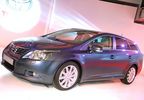
The Toyota Avensis is a large family car built in Derbyshire, United Kingdom by Japanese automaker Toyota since the 1998 model year. It is the successor of the Carina E and is available as a four-door saloon, five-door liftback and estate. A large MPV called the Toyota Avensis Verso (Toyota Ipsum in Japan and previously the Toyota Picnic in other markets) is built in Japan on a separate platform. The Avensis is the basis for the youth-oriented, U.S.-market Scion tC.
The Toyota Avensis was introduced in 1997, to create a more modern name when compared with the reliable, but dull Toyota Carina E/ Toyota Corona. Like its predecessor the Avensis was reliable, and proved a sales success for Toyota Europe. Over the years, the Toyota Avensis has advanced in size, technology, power, and economy to challenge the its established European rivals, the Vauxhall Vectra, Ford Mondeo and Peugeot 407.[citation needed]
Toyota introduced the Avensis nameplate on its new model, essentially an extensive revamp of the previous generation Carina E, which was launched at the end of 1997. Like its predecessor, the Avensis was based on the non-European Corona model and built at the Burnaston factory in Derby. At the same time, production of the five-door Toyota Corolla also started at this British plant.
The original Avensis had the option of four engines (1.6, 1.8 and 2.0-litre petrol and a 2.0-litre turbodiesel) and three body styles (saloon, hatchback and estate). The station wagon was essentially the Japanese-market second generation Toyota Caldina. All of the range gave solid build quality, excellent reliability, a spacious comfortable interior, generous equipment, smooth ride quality and good refinement, but very little in the way of excitement. A facelift in the summer of 2000 (which saw the engines fitted with variable valve timing) made little difference to this, although a sporty Avensis 2.0L SR with bodykit and tuned suspension did become available.
The Avensis Verso large MPV was introduced in 2001, with room for seven occupants and 2.0-litre engines only. The Verso's platform previewed the Avensis second generation. The Avensis Verso won Australia's Best People Mover, where it is simply called Avensis, the other variants unavailable to that market.
The second generation Toyota Avensis was launched in early 2003 an all-new format; this time it offered more in the way of driver involvement and visual appeal. The 1.6, 1.8 and 2.0-litre petrol and 2.0-litre turbodiesel engines were carried over from the previous Avensis, and the 2.4-litre four-cylinder from the Camry was also added to the range. This was the first Avensis that is exported to Japan. Due to the Camry wagon ending production, the Avensis Wagon is exported to New Zealand, in both 1.8 and 2.0-litre forms. In Britain, there were no 1.6 versions available.
In the 2004 European Car of the Year contest, the Avensis was just edged out of the top three by the Fiat Panda, Volkswagen Golf and Mazda 3.
Following the withdrawal of the Toyota Camry in 2004 (2005 in Switzerland), the Avensis became the largest Toyota saloon sold in Europe.
Trim levels in the UK are the T2, T3-S, T3-X, T4, T Spirit and the T180. There is also a special edition, based on the T2 called the Colour Collection. In Ireland there are four trim levels - Aura, Strata, Luna, and Sol.
The original 115PS (85kW) D-4D Diesel engine has been complemented with a 2.2L D-4D in 150PS (110kW) and 177PS (130kW) versions. Newer versions have dropped the "D-4D" and "2.0" badging from the front wings and tailgate respectively.
In Japan, the Avensis is sold as 2.0 Xi, 2.0 Li, and 2.4 Qi. Only the base model 2.0 Xi is offered with 4-wheel drive.
The Avensis Verso continued to be available alongside the new Avensis until 2006. A replacement to take over from the Avensis Verso and Toyota Previa/ Sienna has yet to be unveiled, but is rumoured to feature Toyota's 2.2-litre D-4D engine.
The new facelifted Toyota Avensis became available in June 2006. Some changes from the old model are the inclusion of turn signals in the side mirrors, an MP3/ WMA/ ASL-ready audio system, new front bumper, and a new grille. Interior materials and cloth seats have also been changed for 2006. Its multi display with on-board computer will be integrated in optitron display and is navigation ready. Also added are automatic headlights and a height-adjustable front passenger seat.
The most notable mechanical difference is the addition of a 124bhp (92kW) D-4D engine. This, coupled to a six-speed manual gearbox has lowered fuel consumption, emissions, and gives a quoted 0-60mph time of 10.5 seconds.
The third generation Toyota Avensis was revealed at the 2008 Paris Motor Show, before going on sale in January 2009. It is being built at Toyota's Burnaston plant in Derbyshire, England, just like the current model.
It has been said to be powered by new clean, economical petrol engines, a 2.0 vvt-i and 1.8 vvt-i petrol units with Toyota's Valvematic technology, and a pair of 2.0 and 2.2 Diesel engines. Some rumours have confirmed a hybrid version of this new Avensis.
From Wikipedia, the free encyclopedia
More About Toyota Avensis
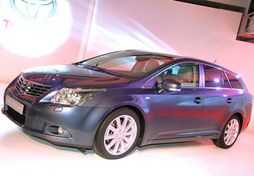
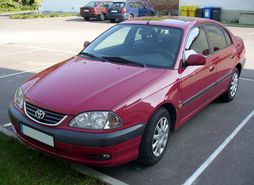
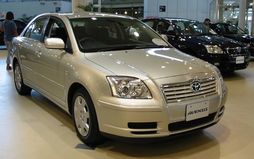
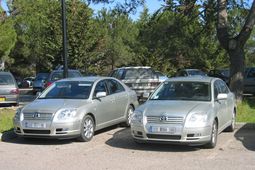
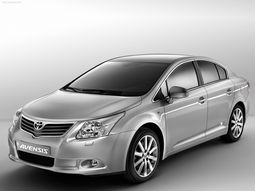
|